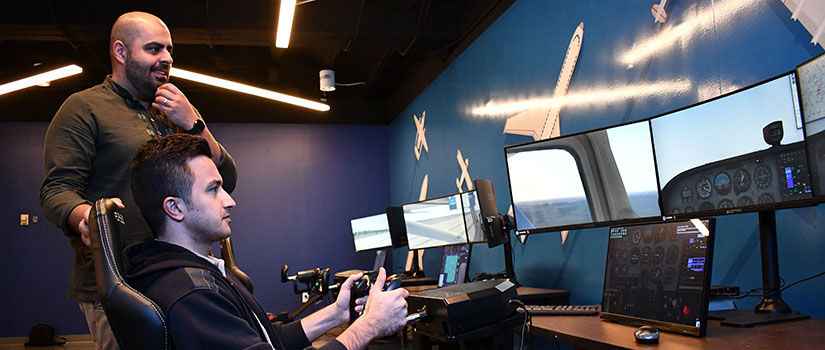Aerospace engineering is a major driver of South Carolina’s economy. According to an SC Aerospace study, the industry directly contributes $14 billion to South Carolina’s gross domestic product and creates more than 130,000 jobs.
South Carolina and surrounding states are home to more than 450 aerospace-related companies. When Boeing opened a factory in North Charleston, South Carolina in 2011, there were no undergraduate aerospace engineering programs in the state, which meant the company relied on skilled employees from nearby states.
The University of South Carolina’s aerospace engineering undergraduate program was founded in 2018 as the first in the state. It was created in response to growing job demand and remains the only program of its kind in South Carolina. “The program keeps motivated students in South Carolina and prepares them for aerospace engineering jobs statewide,” says Wout De Backer, who was promoted to assistant professor this past January.
Despite the program’s humble beginnings, it has experienced tremendous growth. The first graduating class consisted of four students, all of whom changed their major from mechanical engineering. The program’s enrollment grew to 150 students by fall 2021 and expected to continue growing in the coming years.
Learning these hard topics transitions really well to anything else. If you can learn orbital mechanics, I think you can learn how to do a lot of things.
- Drew Sander, senior, aerospace engineering major
When the aerospace engineering program began, the courses were built around the current faculty’s skills. The courses mostly covered manufacturing and materials but lacked depth in aerodynamics and propulsion. The current faculty includes two new members who joined this fall, all with diverse areas of expertise.
Sang Hee Won, who has been the program’s interim director since January 2020, has received positive feedback from the faculty during his time with the program. “These students are highly motivated,” Won says. “The faculty have said they can have entertaining and dynamic classes where students ask a lot of questions. Overall, students are more engaged.”
Under Won’s guidance, the curriculum recently underwent a significant change. Prior to the current academic year, the aerospace engineering program allowed students to choose one of five tracks: aeromechanical systems, integrated information technology, power electronics systems, control systems or communication systems. However, these tracks required students to take classes that were designed for other majors, and the chosen track was not indicated on students’ transcripts. Students now can choose several aerospace electives that cover a smaller range of topics. Students looking to expand their knowledge have the option to minor in related subjects like electrical or nuclear engineering.
Won explains that the new system benefits students and streamlines the degree path. “Instead of doing a lot of hard work that does not appear on their diploma, students can go more in depth on the aerospace engineering topics and easily obtain a minor.”
Throughout the program, students take classes that introduce them to a variety of equipment, including a low-speed wind tunnel, stationary and moving-base flight simulators, and computer labs with state-of-the-art computer-aided design software. The college also provides access to 3D printing and a makerspace that is available to all students.
“In the next 5 to 10 years, we envision expanding our research capabilities and acquiring state-of-the-art equipment such as high-speed imaging systems and a hypersonic wind tunnel that will introduce cutting-edge technologies to students,” Won says.
Students admit that even though the coursework is rigorous, the experience is rewarding. “You definitely get better at critical thinking, says Nicholas Kozma, a recent graduate who now works for Bosch. “You have your specific set of tools that are given to you by the professor and then you’re handed an exam with a problem you've never seen before and use that tool belt to dismantle the problem and solve it as effectively as you can.”
As the program gains traction, the faculty has been pursuing accreditation from the Accreditation Board for Engineering and Technology (ABET), an organization that assesses higher education programs to ensure they meet quality standards and prepare students for the workforce. The process will begin this month and receiving ABET accreditation will ensure that the degree will be recognized internationally by employers and other universities.
“Seeing the lightbulb moments happen with the students in my courses is what I find most enjoyable. It validates that we’re teaching the right things and connecting the dots,” De Backer says.
The aerospace engineering program continues to fill a unique role in South Carolina’s economy. For students interested in careers with companies such as Boeing and Lockheed Martin, there are plans to hire more faculty to expand the program’s focus on astronautical engineering. Professors are also committed to fulfilling students’ needs and encouraging them to pursue aerospace-related careers.
“I was always amazed by engineers because ideas don’t just stay at ideas,” says Ana Victoria Kock, a member of the program’s first graduating class who is now pursuing a master’s degree. “You can make something that is solid and practical, something that helps people and solves problems. Engineers build and shape the future.”
